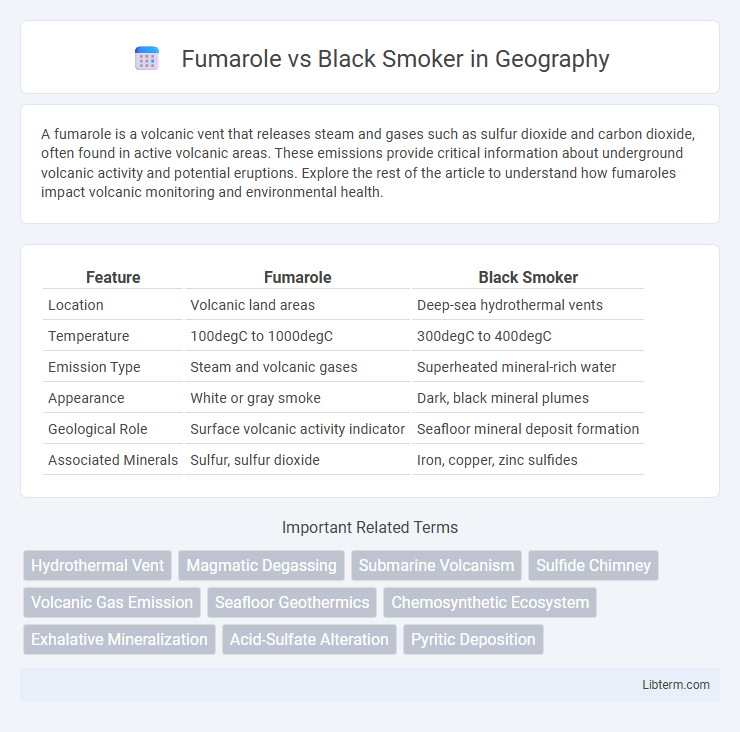A fumarole is a volcanic vent that releases steam and gases such as sulfur dioxide and carbon dioxide, often found in active volcanic areas. These emissions provide critical information about underground volcanic activity and potential eruptions. Explore the rest of the article to understand how fumaroles impact volcanic monitoring and environmental health.
Table of Comparison
| Feature | Fumarole | Black Smoker |
|---|---|---|
| Location | Volcanic land areas | Deep-sea hydrothermal vents |
| Temperature | 100degC to 1000degC | 300degC to 400degC |
| Emission Type | Steam and volcanic gases | Superheated mineral-rich water |
| Appearance | White or gray smoke | Dark, black mineral plumes |
| Geological Role | Surface volcanic activity indicator | Seafloor mineral deposit formation |
| Associated Minerals | Sulfur, sulfur dioxide | Iron, copper, zinc sulfides |
Introduction to Fumaroles and Black Smokers
Fumaroles are openings in the Earth's crust that emit steam and volcanic gases such as sulfur dioxide and hydrogen sulfide, typically found in volcanic regions. Black smokers are hydrothermal vents on the ocean floor, releasing superheated, mineral-rich water that precipitates sulfide minerals, creating chimney-like structures. Both fumaroles and black smokers play crucial roles in geothermal and marine ecosystems by cycling minerals and supporting unique biological communities.
Defining Fumaroles: What Are They?
Fumaroles are openings in the Earth's crust typically found near volcanic areas, releasing steam and volcanic gases such as sulfur dioxide and carbon dioxide at high temperatures. Unlike black smokers, which emit superheated mineral-rich water from oceanic hydrothermal vents, fumaroles primarily expel gaseous emissions that result from magma heating groundwater. These geothermal features play a key role in volcanic gas release and help scientists monitor volcanic activity and geothermal energy potential.
What Are Black Smokers?
Black smokers are deep-sea hydrothermal vents that emit superheated, mineral-rich water, reaching temperatures up to 400degC, which causes the surrounding seawater to precipitate sulfide minerals, giving the plumes their characteristic black color. These vents are typically found along mid-ocean ridges, such as the East Pacific Rise and the Mid-Atlantic Ridge, where tectonic plates diverge and magma heats seawater circulating through the ocean crust. Unlike fumaroles, which release steam and volcanic gases on land, black smokers provide unique ecosystems hosting chemosynthetic bacteria that form the base of a complex food web in the deep ocean.
Formation Processes: Fumarole vs Black Smoker
Fumaroles form when volcanic gases escape through cracks in the Earth's crust, emitting steam and sulfur-rich gases at relatively low temperatures around 100-300degC. Black smokers emerge at mid-ocean ridges where superheated seawater, heated up to 350degC by magma, dissolves minerals and precipitates metal sulfides upon contact with cold ocean water, creating chimney-like structures. The key differentiation in formation lies in fumaroles being gas-driven emissions on land, whereas black smokers are hydrothermal vents formed by mineral-laden fluids in deep-sea volcanic settings.
Geological Locations and Distribution
Fumaroles primarily occur in volcanic regions such as the Pacific Ring of Fire, Yellowstone Caldera, and the Kamchatka Peninsula, where geothermal activity heats groundwater and releases steam and volcanic gases. Black smokers are predominantly found along mid-ocean ridges, such as the East Pacific Rise and the Mid-Atlantic Ridge, where tectonic plate divergence allows seawater to circulate through heated volcanic crust, emitting mineral-rich hydrothermal fluids. These distinctive geological settings influence the distribution of fumaroles on land and black smokers on the seafloor, reflecting their formation processes tied to volcanic and tectonic activity.
Temperature and Chemical Composition Differences
Fumaroles emit gases at lower temperatures ranging from 100degC to 300degC, primarily releasing steam along with sulfur dioxide, carbon dioxide, and hydrogen sulfide, reflecting volcanic gas emissions. Black smokers discharge superheated fluids exceeding 350degC, rich in dissolved metals such as iron, copper, and zinc, which precipitate upon contact with cold seawater to form characteristic dark mineral plumes. These distinct temperature ranges and chemical compositions highlight fumaroles as surface volcanic vents, whereas black smokers function as deep-sea hydrothermal vent systems depositing sulfide mineral deposits.
Ecosystems and Biological Communities
Fumaroles host unique thermophilic microbial communities adapted to acidic, sulfur-rich environments with moderate temperatures, supporting specialized archaea and bacteria. Black smokers emit superheated, mineral-rich fluids, creating hydrothermal vent ecosystems that sustain diverse, chemosynthetic organisms such as tube worms, clams, and shrimp. These biological communities thrive on chemical energy from Earth's interior, forming complex ecosystems independent of sunlight.
Visual Characteristics and Physical Appearance
Fumaroles emit steam and volcanic gases, often displaying a white or grayish plume with mineral deposits around the vent, resulting in a crusty, often colorful surface of sulfur and other minerals. Black smokers release dark, dense plumes of superheated, mineral-rich water that appear black due to the precipitation of metal sulfides, forming chimney-like structures made of iron, copper, and zinc sulfides. The stark contrast between the white, gas-dominated emissions of fumaroles and the dark, particulate-laden effluents of black smokers defines their distinct visual and physical characteristics at hydrothermal sites.
Scientific Importance and Research Significance
Fumaroles and black smokers are hydrothermal features that provide critical insights into geothermal and geochemical processes beneath the Earth's surface. Fumaroles emit volcanic gases and steam, enabling the study of magmatic activity, gas compositions, and volcanic monitoring, while black smokers release mineral-rich superheated fluids from deep-sea hydrothermal vents, contributing to research on subseafloor microbiology, mineral deposition, and ocean chemistry. Both play essential roles in understanding Earth's geothermal dynamics, deep biosphere ecosystems, and natural resource formation.
Fumarole and Black Smoker: Key Differences Summarized
Fumaroles emit steam and volcanic gases at lower temperatures typically below 450degC, whereas black smokers release superheated mineral-rich water exceeding 350degC, creating dense, dark plumes on the seafloor. The chemical composition of fumarole emissions primarily includes water vapor, sulfur compounds, and trace volcanic gases, contrasting with black smokers that discharge metal sulfides such as iron, copper, and zinc, forming mineral-rich chimneys. Fumaroles are commonly found in terrestrial volcanic regions, while black smokers occur in deep-sea hydrothermal vent ecosystems along mid-ocean ridges.
Fumarole Infographic

 libterm.com
libterm.com